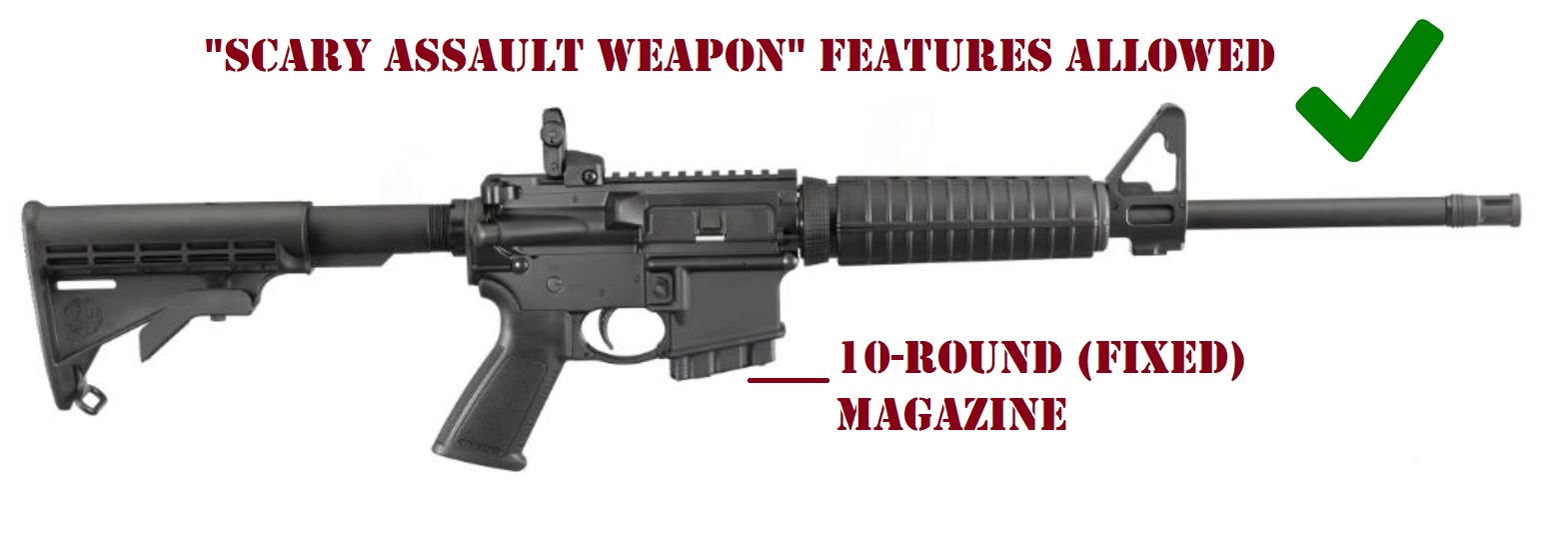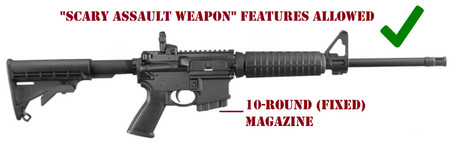How to Build a California-Legal AR-15
Posted by Gun Builders Depot on Jun 18th 2020
Living in California and owning firearms can be like getting a tooth pulled. It can be painful. The good news is that Novocain exists for teeth, and genius exists for owning guns in California. Hats off to the creators, lawyers, and manufacturers who go above and beyond to make owning common rifles, like the AR-15, possible in states like California. California often carries the gun control banner that many states often follow.
Building a CA-Legal AR? You Have Two Options
Effective January 1, 2000, California Senate Bill 23 holds that an assault weapon contains certain parts or accessories. If you want to build a "California-compliant" AR, you have two choices: Build a rifle that can take good ole' detachable magazines, and avoid all those "scary assault weapon" features. Or, build a rifle with a fixed 10-round magazine and enjoy those scary features by configuring your AR-15 like a (mostly) normal rifle.
If you want to stick with detachable magazines, S.B. 23 (Assault Weapon Characteristics) says your AR-15 or similar rifle cannot have any of the features below. This is how S.B. 23 defines an assault weapon according to state law:
- A semiautomatic, centerfire rifle that does not have a fixed magazine but has any one of the following:
- A pistol grip that protrudes conspicuously beneath the action of the weapon.
- A thumbhole stock.
- A folding or telescoping stock.
- A grenade launcher or flare launcher.
- A flash suppressor.
- A forward pistol grip.
- A semiautomatic, centerfire rifle that has a fixed magazine with the capacity to accept more than 10 rounds.
- A semiautomatic, centerfire rifle that has an overall length of less than 30 inches.
So with this is mind let's look at the two options for building a California Compliant AR-15.
Option 1: Fixed 10-Round Magazine + Features

The most common work-around was addressing the first point of the legislation, and turning a removable magazine into a fixed magazine. At first, AR builders made their AR magazines fixed by installing something called a Bullet Button. The Bullet Button replaced the factory magazine release with a smaller button that required a tool (like a punch) to remove the magazine. Since it couldn't be operated with one's finger, the Bullet Button qualified as a fixed-magazine solution. At least for awhile.
In 2017, California passed Senate Bill 880, the dreaded Bullet Button Ban. S.B. 880 specifically redefined what a fixed magazine was under California's Assault Weapon Definitions: "[A fixed magazine is] an ammunition feeding device contained in, or permanently attached to, a firearm in such a manner that the device cannot be removed without disassembly of the firearm action."
Since bullet buttons didn't require breaking the upper and lower receivers apart to remove a magazine, they were no longer considered fixed-magazine conversions. The updated legislation (page 4) also says that disassembly means:
"The fire control assembly is detached from the action in such a way that the action has been interrupted and will not function. For example, disassembling the action on a two part receiver, like that on an AR-15 style firearm, would require the rear take down pin to be removed, the upper receiver lifted upwards and away from the lower receiver using the front pivot pin as the fulcrum, before the magazine may be removed."
That meant a new (and still-current) type of fixed-magazine conversion had to be used.
AR MagLock and Fixed-Magazine Receivers
The first new fixed-mag option came in the form of the AR MagLock. This new conversion requires the shooter to partially separate the upper and lower receivers by pulling the rear takedown pin out. As the receivers partially separate, a mechanism unlocks the magazine, allowing it to be removed. Insert a new magazine, pop the takedown pin back in, and you're all set.
Today, there are various manufacturers that have developed different versions of the MagLock. Some automatically drop the magazine when the receivers are separated. Others have stops built in to prevent the receivers from separating too much, allowing just enough space for the magazine to be removed, which makes for quicker reloads. Some include new takedown pins that are spring-loaded or come with pull tabs. Any of these conversion kits (when used with a 10-round magazine) will allow you to get around S.B. 23's bans on buttstocks, grips, and accessories.
Still, some just want to use the AR-15's magazine release the way it was intended. If that sounds like you, there is a second choice for building a California-compliant AR-15. It'll still allow you to keep those features that are banned in different, legal configurations.
Option 2: Detachable Magazines, Featureless Rifle
Featureless rifles are built to allow for the use of removable magazines while avoiding all the features California defines as parts of an Assault weapon. This means you cannot have a flash suppressor and have to use a modified grip and buttstock, shown below in one example called the Hera Arm Stock. You could also replace the pistol grip with a hand grip that doesn't allow you to wrap your hand around it fully, in combination with a fixed buttstock. Of course, you won't be able to install that flashy 37mm flare launcher or have a forward pistol grip, either. The featureless rifle gets around the Assault Weapons ban without effectively hindering your rifle's performance, and you still get to use detachable magazines. California is a silly state, but gun makers are more creative.
Is [Feature] Considered an Assault Weapon Part?
California tends to avoid designating what's legal when it comes to assault weapons, semiautomatic rifles, and the specific parts that may or may not be considered assault weapon components. Thankfully, the California Code of Regulations, Title 11, Division 5, Chapter 3, Article 2 (Registration Requirements, What Qualifies for Registration, and Definitions) provides specific definitions for all those scary parts. If you're going with a "featureless rifle" and want to know whether a certain accessory would be banned under S.B. 23, read the definitions for those parts in that Article.
Laws and Lawyers
Laws are always changing, especially in states that tend to be anti-gun, like California. This guide is not meant to serve as legal counsel or any type of legal advice. If you're unsure about buying, building, or owning a firearm in California or any other state, contact an attorney. Remember to always check federal, state, and local laws before building any firearm.
DISCLAIMER: If you are new to the world of DIY gun building, you likely have a lot of questions and rightfully so. It’s an area that has a lot of questions that, without the correct answers, could have some serious implications. At GunBuilders.com, we are by no means providing this content on our website to serve as legal advice or legal counsel. We encourage each and every builder to perform their own research around their respective State laws as well as educating themselves on the Federal laws. When performing your own research, please be sure that you are getting your information from a reliable source.

